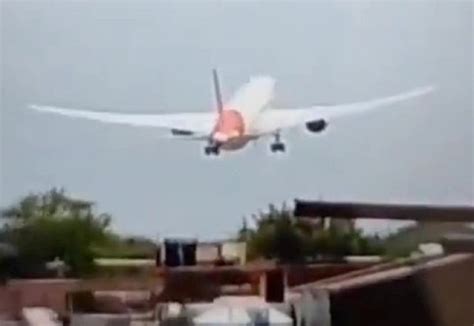
A viral video taken by a passenger aboard an Air India flight has ignited widespread concern after he documented numerous malfunctions, raising questions about the safety of the aircraft.
An Air India passenger’s video, which has rapidly circulated online, paints a troubling picture of a recent flight where multiple systems appeared to be malfunctioning, prompting serious concerns about aircraft maintenance and passenger safety. The man, identified as a business class passenger on Air India flight AI806 from Newark (EWR) to Mumbai (BOM) on June 14, 2024, meticulously documented the issues, stating that “nothing seems to be working” on the Boeing 777-300ER aircraft. His footage and commentary have since sparked a wave of reactions and calls for investigation into the airline’s operational standards.
In the video, the passenger highlights a series of problems, beginning with a malfunctioning entertainment system. “So here we are on Air India 806 from Newark to Bombay, and nothing seems to be working,” he begins, before panning the camera to show a blank, unresponsive screen. This initial inconvenience, however, quickly escalated to more significant issues. The passenger further demonstrates that the overhead lights were flickering erratically, and the seat’s recline function was inoperable. He then revealed that the charging ports were also not functioning, leaving passengers unable to power their electronic devices throughout the long-haul flight.
The most alarming part of the video showed the air conditioning system failing, causing the cabin temperature to rise uncomfortably. The passenger notes the sweltering conditions and expresses concern for the well-being of those on board, especially given the duration of the flight. “The AC is not working,” he says, visibly sweating. “It’s going to be a long, long flight.” He voiced his apprehension about the flight, suggesting the aircraft may have been compromised.
The video quickly gained traction across social media platforms, triggering a flurry of reactions from concerned travelers and aviation experts alike. Many questioned Air India’s maintenance protocols and expressed fears about potential safety lapses. Social media users tagged the airline in their comments, demanding explanations and assurances about the airworthiness of their fleet. The incident is particularly sensitive given Air India’s ongoing efforts to revamp its image and improve customer service following its acquisition by the Tata Group in January 2022.
In response to the viral video, Air India issued a statement acknowledging the technical issues experienced on the flight. The airline stated, “We are aware of the issues experienced by a passenger on flight AI806 operating Newark-Mumbai on June 14. While some of the issues were minor and related to passenger comfort, we regret the inconvenience caused. Our engineering teams are reviewing the matter, and we are taking corrective steps.” The airline added that the safety of its passengers is their utmost priority and that they are committed to maintaining high standards of operational excellence.
Despite Air India’s statement, the incident has intensified scrutiny of the airline’s operations. Aviation experts have weighed in on the matter, emphasizing the importance of thorough pre-flight checks and prompt maintenance to prevent such incidents. Some experts pointed out that while individual malfunctions may not pose immediate safety risks, a confluence of multiple issues could indicate underlying problems with the aircraft’s overall condition. The incident also raises broader questions about the aging fleets of many airlines and the challenges of maintaining older aircraft to modern standards.
This is not the first time Air India has faced criticism over its service and maintenance standards. In recent years, the airline has been plagued by complaints ranging from flight delays and baggage handling issues to concerns about cleanliness and onboard amenities. The Tata Group’s acquisition was intended to address these shortcomings, with significant investments planned for fleet modernization, staff training, and customer service enhancements. However, incidents like the recent flight AI806 highlight the significant challenges that remain in turning around the airline’s reputation.
The incident also highlights the growing power of social media in holding airlines accountable. Passengers are increasingly using platforms like Twitter, Facebook, and Instagram to document their travel experiences, both positive and negative. These posts can quickly go viral, attracting widespread attention and putting pressure on airlines to respond promptly and effectively. In the case of Air India flight AI806, the passenger’s video served as a powerful catalyst for public scrutiny and prompted the airline to address the concerns raised.
The incident involving Air India flight AI806 serves as a stark reminder of the importance of rigorous maintenance and safety standards in the aviation industry. While the airline has taken steps to address the issues raised, the incident underscores the need for continuous vigilance and improvement to ensure passenger safety and confidence. The broader implications of this incident extend beyond Air India, highlighting the challenges faced by airlines worldwide in maintaining aging fleets and meeting the expectations of increasingly demanding passengers in the age of social media.
The investigation into the incident is ongoing, with aviation authorities likely to examine the aircraft’s maintenance records and conduct further inspections to determine the root cause of the malfunctions. The outcome of this investigation could have significant implications for Air India, potentially leading to stricter oversight and additional measures to ensure the safety and reliability of its operations. Furthermore, the incident may prompt a broader review of maintenance practices across the aviation industry, with a renewed focus on proactive measures to prevent similar incidents in the future.
In-Depth Analysis:
The Air India flight AI806 incident is not merely a case of passenger inconvenience; it represents a confluence of issues that collectively raise serious questions about the airline’s commitment to safety and operational excellence. While the airline has acknowledged the problems and promised corrective action, a deeper analysis reveals the potential systemic challenges Air India faces in its ongoing transformation.
Maintenance and Fleet Management:
The fact that multiple systems failed simultaneously—entertainment, lighting, seat recline, charging ports, and, most critically, the air conditioning—suggests a potential lack of thoroughness in pre-flight checks or underlying issues with the aircraft’s maintenance schedule. The Boeing 777-300ER, while a reliable aircraft, requires diligent maintenance to ensure all systems are functioning correctly, especially on long-haul routes.
Aging Fleet Considerations: Air India has a mixed fleet of aircraft, some of which have been in operation for a considerable period. While older aircraft can be maintained to a high standard, they require more frequent and detailed inspections. The cost of maintaining an aging fleet can be substantial, and there is a risk that economic pressures might lead to compromises in maintenance quality.
Potential for Cost-Cutting Measures: Following its acquisition by the Tata Group, Air India has been under pressure to improve its financial performance. While investments in modernization are planned, there could be a temptation to cut costs in the short term, potentially affecting maintenance budgets and staffing levels.
Passenger Safety and Comfort:
The failure of the air conditioning system is particularly concerning. On a long-haul flight from Newark to Mumbai, the cabin temperature can rise to uncomfortable and even dangerous levels, especially for passengers with pre-existing health conditions. Dehydration, heat exhaustion, and other heat-related illnesses are potential risks.
Compromised Passenger Experience: Beyond safety concerns, the malfunctions significantly degrade the passenger experience. Inoperable entertainment systems, lighting issues, and non-functional charging ports can make a long flight even more tedious and uncomfortable, leading to passenger dissatisfaction and reputational damage for the airline.
Impact on Crew Performance: Malfunctioning systems can also affect the performance of the flight crew. Dealing with passenger complaints and managing the technical issues can add to their workload and stress levels, potentially impacting their ability to focus on safety-critical tasks.
Regulatory Oversight and Accountability:
The Air India flight AI806 incident will likely attract the attention of aviation regulatory authorities, both in India and the United States. These agencies have the power to conduct inspections, review maintenance records, and impose fines or other penalties if they find evidence of negligence or non-compliance with safety regulations.
Importance of Independent Investigation: A thorough and independent investigation is crucial to determine the root cause of the malfunctions and identify any systemic issues that need to be addressed. The investigation should involve aviation experts, maintenance professionals, and representatives from both the airline and the regulatory authorities.
Transparency and Public Trust: Airlines have a responsibility to be transparent with the public about safety-related incidents. Air India’s initial response was a step in the right direction, but the airline needs to provide more detailed information about the investigation and the corrective actions being taken to restore public trust.
Social Media’s Role in Accountability:
The viral video of the Air India flight AI806 incident demonstrates the growing power of social media in holding airlines accountable. Passengers are no longer passive recipients of airline services; they are active participants who can quickly share their experiences with a global audience.
Amplification of Passenger Voices: Social media platforms amplify the voices of individual passengers, allowing them to reach a much wider audience than they could through traditional channels. This can put significant pressure on airlines to respond quickly and effectively to complaints and concerns.
Reputational Risk: Negative social media coverage can have a significant impact on an airline’s reputation, potentially leading to a decline in bookings and revenue. Airlines need to be proactive in monitoring social media channels and responding to passenger feedback in a timely and professional manner.
Demanding Increased Transparency: Social media also creates a demand for increased transparency from airlines. Passengers expect airlines to be open and honest about safety-related incidents and to provide clear explanations of what happened and what is being done to prevent similar incidents in the future.
Air India’s Transformation Challenges:
The incident underscores the challenges that Air India faces in its ongoing transformation under the Tata Group’s ownership. While the company has ambitious plans to modernize its fleet, improve customer service, and restore its reputation, it must also address underlying issues related to maintenance, safety, and operational efficiency.
Balancing Investment and Cost Control: Air India needs to find a balance between investing in new aircraft and technologies and controlling costs in the short term. Cutting corners on maintenance or safety could have disastrous consequences, both for the airline and for its passengers.
Cultural Change: Transforming Air India’s culture is another key challenge. The airline needs to foster a culture of safety, accountability, and customer service at all levels of the organization. This requires strong leadership, effective training, and a commitment to continuous improvement.
Competition and Market Pressure: Air India operates in a highly competitive market, facing challenges from both domestic and international airlines. The airline needs to differentiate itself by offering superior service, reliability, and safety. Incidents like the Air India flight AI806 incident can undermine these efforts and make it more difficult for the airline to compete effectively.
Recommendations for Air India:
- Enhance Maintenance Procedures: Conduct a comprehensive review of maintenance procedures to ensure that all aircraft systems are thoroughly inspected and maintained according to the highest standards.
- Invest in Fleet Modernization: Accelerate the fleet modernization program to replace older aircraft with newer, more reliable models.
- Improve Customer Service: Enhance customer service training for all employees to ensure that passengers are treated with respect and professionalism, even in challenging situations.
- Strengthen Communication: Improve communication with passengers, both during and after incidents, to keep them informed of the situation and the steps being taken to address it.
- Increase Transparency: Be more transparent with the public about safety-related incidents and the steps being taken to prevent similar incidents in the future.
- Foster a Culture of Safety: Promote a culture of safety at all levels of the organization, where employees are encouraged to report safety concerns without fear of reprisal.
- Engage with Social Media: Actively monitor social media channels and respond to passenger feedback in a timely and professional manner.
- Cooperate with Regulatory Authorities: Fully cooperate with aviation regulatory authorities in their investigation of the Air India flight AI806 incident.
Broader Implications for the Aviation Industry:
The Air India flight AI806 incident has broader implications for the aviation industry as a whole. It highlights the importance of rigorous maintenance and safety standards, the need for transparency and accountability, and the growing power of social media in holding airlines accountable.
Airlines worldwide need to learn from this incident and take steps to ensure that similar problems do not occur on their own flights. This includes investing in maintenance, training employees, improving communication, and being transparent with the public.
The aviation industry also needs to address the challenges of maintaining aging fleets and meeting the expectations of increasingly demanding passengers in the age of social media. This requires innovation, collaboration, and a commitment to continuous improvement.
Ultimately, the safety and reliability of air travel depend on the collective efforts of airlines, regulatory authorities, and passengers. By working together, we can ensure that flying remains the safest and most efficient mode of transportation in the world.
Frequently Asked Questions (FAQ):
1. What happened on Air India flight AI806 from Newark to Mumbai on June 14, 2024?
On Air India flight AI806, several malfunctions were reported, including a non-functional entertainment system, flickering overhead lights, inoperable seat recline, non-functioning charging ports, and a malfunctioning air conditioning system. A passenger documented these issues in a viral video.
2. What was Air India’s response to the viral video and passenger concerns?
Air India acknowledged the technical issues experienced on the flight and stated, “We are aware of the issues experienced by a passenger on flight AI806 operating Newark-Mumbai on June 14. While some of the issues were minor and related to passenger comfort, we regret the inconvenience caused. Our engineering teams are reviewing the matter, and we are taking corrective steps.” The airline emphasized its commitment to passenger safety.
3. What concerns did aviation experts raise in response to the incident?
Aviation experts emphasized the importance of thorough pre-flight checks and prompt maintenance to prevent such incidents. They noted that while individual malfunctions may not pose immediate safety risks, a confluence of multiple issues could indicate underlying problems with the aircraft’s overall condition. Concerns were also raised about the challenges of maintaining aging aircraft fleets.
4. How might this incident affect Air India’s ongoing efforts to improve its service and reputation?
The incident poses a significant challenge to Air India’s efforts to revamp its image and improve customer service following its acquisition by the Tata Group. It highlights the need for continued investment in fleet modernization, staff training, and improved maintenance protocols to restore passenger confidence. The incident could lead to stricter regulatory oversight and additional measures to ensure the safety and reliability of its operations.
5. What is the role of social media in incidents like this involving airlines?
Social media plays a crucial role in holding airlines accountable by allowing passengers to document and share their experiences, both positive and negative, with a wide audience. The viral nature of such posts can quickly attract widespread attention, putting pressure on airlines to respond promptly, transparently, and effectively to address passenger concerns and potential safety issues. This incident underscores the growing power of social media in shaping public perception and influencing airline accountability.









